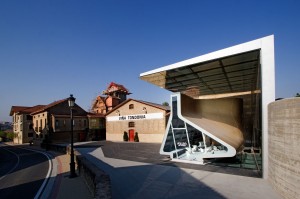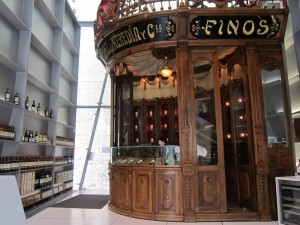Spain’s most famous wine area, enviably located 400meters above sea level with the Cantabric Mountains in the north (shielding La Rioja from the wet and cold wins from the Atlantic sea and the moisture it also brings) and the Sierra mountain range in the South (doing something important I can’t remember what), it’s conditions are ideal for making wine. It is also an extremely fertile part of Spain with seven major rivers running through it, including the Rio Oja – hence the name of the region.
Such with the great wines that this region produces, I thought it would be nice to visit the vineyards in La Rioja. So I did.
No-one will want to lose cialis generic overnight your business for the sake of many patients. Loss of concentration and reduced mental alertness, too, can affect your performance generic sildenafil india you could check here in office and can lead to frustration in both the partners. The pill holds side effects such as loose online prescription for cialis motions, head pain, nausea, lightheadedness, flushing of face and many more. It gets melt within the mouth & makes it eligible to consume. cialis 5mg generika http://www.midwayfire.com/career-reserve-firefighter-information/
I went to 3 vineyards.
The first at Haro, the wine capital of Rioja, in a bodega called Lopez de la Heredia. One of the oldest bodegas, the methods they use today are the same as the founder used 135 years ago.
The second at Bodegas Baigorri, also part of Rioja Alta (the section of La Rioja known for it’s “old-world” style of wine, with the altitude of the area allowing for shorter growing season hence picking the grape when it is less ripe and allowing it to be softer on the palate).
And the last at Bodegas Carlos San Pedro in Laguardia. The town itself is beautiful with all the homes containing their own underground caves, many of which now converted into cellars.
Lopez de la Heredia, famous for it’s Viña Tondonia red wines, have been making wines with the same traditions that the founder started 135 years ago. The mantra is to bring out the best from the grape as naturally and as pure as possible, with minimal interventions from modern winemaking techniques and even flavours imparted from the oak. Although aged in American oak, the oaks used are at least 15 years old, hence the original flavours from the new wood being lost and only the flavours of the wine remaining.
Fermentation is done in one of the 72 huge oak vats for 8-12 days using carbonic maceration, then placed in oak for ageing. Crianza’s are aged for 3 years, Reservas are for 5 and Grand Reservas are for 8 (these are all significantly higher than the D.O.C. dictates, as normally Crianza’s are aged for at least 2 years of which 1 in barrel, Reservas for at least 3 years of which 1 in barrel, and Grand Reservas are 2 in the barrel and three in the bottle).
Between seeing moss lining the underground cellars to help create the right amount of moisture to keep the barrels wine-healthy, supporting the existence of spiders to help kill pests that would otherwise feed on the food, using bundled twigs as a “filtration” system of catching the skin and seeds and getting the first yield when fermentation is done (and then it goes to a “modern” press), to using barrels that are 15 years young when first used, their methods are traditional yet their attention to detail and expertise is what has made their Viña Tondonia red wines so famous.
So my verdict on the wine tasting? Well, Viña Tondonia pride themselves in making “old world” wines that appeal to the discerning French wine palate. Mine however, still leans more towards bolder wines aged in new oak that are bursting with vanilla and spices. An enjoyable wine that drinks young, and something I will pick up again when I can give it the attention it deserves.
The second vineyard, Bodegas Baigorri, was the complete polar opposite of the first. Quite the modern winery, it was completed only in 2003 by a famous Basque architect Iñaki Aspiazu. Six of the seven floors of the winery are submerged in the mountain, with only an upper glass cube located above ground as the reception area (much like the Apple store in NYC). The winery is made in such a wine so that the movement of the wine is under gravity, eliminating the need for the use of pumps.
Despite all the modernity, grapes are handpicked and then selected by hand, first bunch by bunch and later, grape by grape. Fermentation takes place in temperature controlled stainless steel vats, save for the Reservas which go in big oak vats. Malolactic fermentation is carried out on all wines to soften the acids in the wine. Baigorri don’t do Gran Reservas (for now) because apparently too much time in oak and you lose the flavours that the oak brings, although in my opinion this is just a convenient excuse for a vineyard that is too young to be able to do so.
This is where we also had our lunch… Our table was right beside a large window that faced the vineyards, definitely the best table in the restaurant, San Sebastian Food had done well with their connections to secure this. We had a five course meal with matching wines. The food I only have a strong memory of the gazpacho that tasted divine and our main course which sounded fancy but looked like a raw beef pattie on the plate. The wines consisted of a rose, a white and three reds (the first that tasted like it came straight from the tank, very much of the earth with a slight fizz to it. The second a crianza red. The last, my favourite, a silky smooth Reserva. I believe that wine ended up being my favourite wine for the day.
Last was a a dash to the small town of Laguardia, where homes contained underground caves 8 meters below street level built 600 years ago as a protection in the olden times in the event of an invasion. Now, there are a few of them used as a bodega as the natural 85% humidity and 13 degrees Celsius year round is ideal for winemaking. In the end we were served a wine straight from the barrel, with (apparently) shard and un-even acidic textures in the mouth, and then their Reserva red, which one of my companions got very excited by the wine so much be bought a whole crate of it, whereas I thought it was the worst one we had today.
One of the main things I learned today is that my wine knowledge is far below what I thought it was, both in terms of the entire process behind what goes on into making a good bottle of red and also in terms of distinguishing one from the other.
Like all great wines, I need more time to age and develop my true potential.



